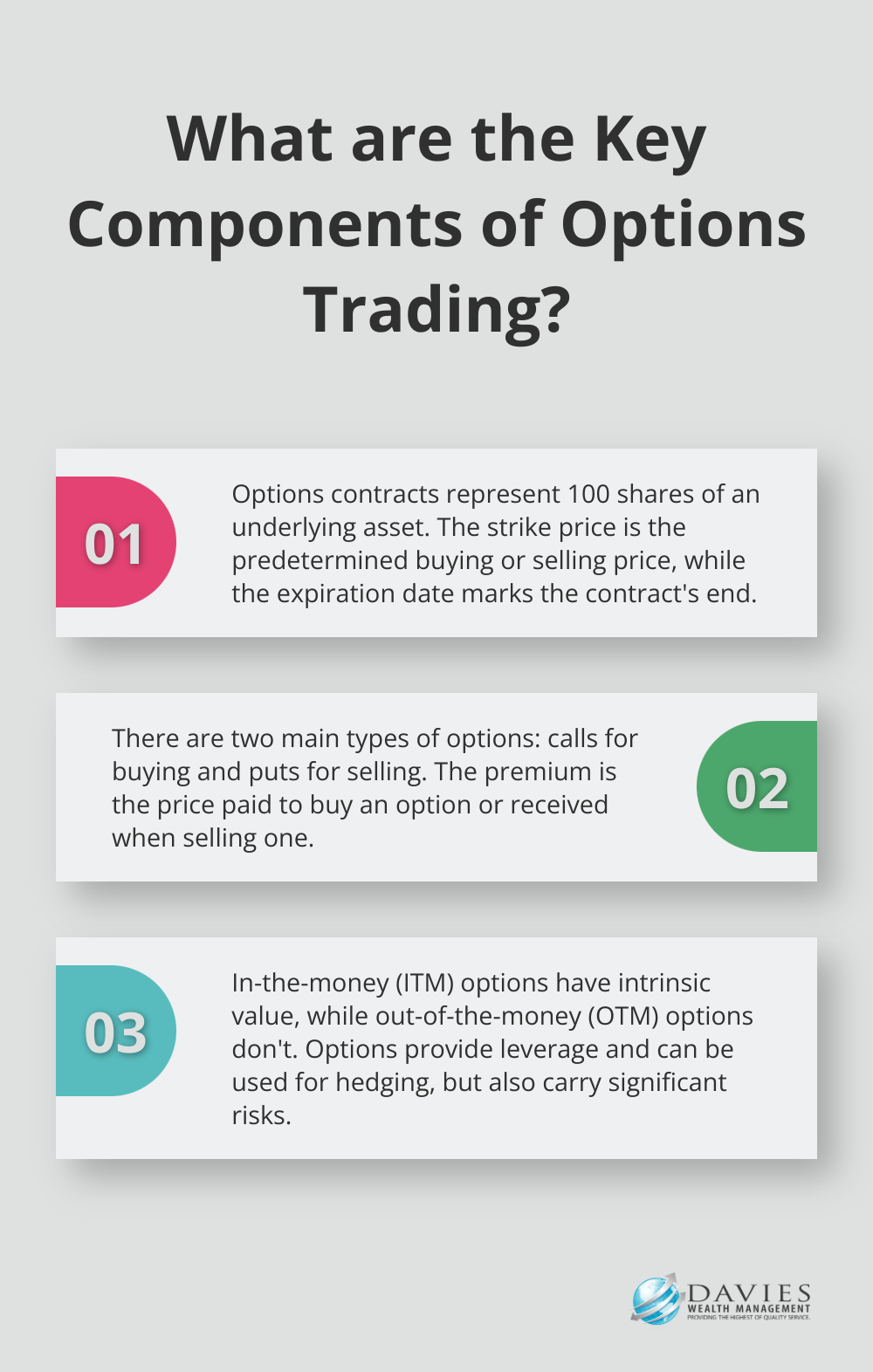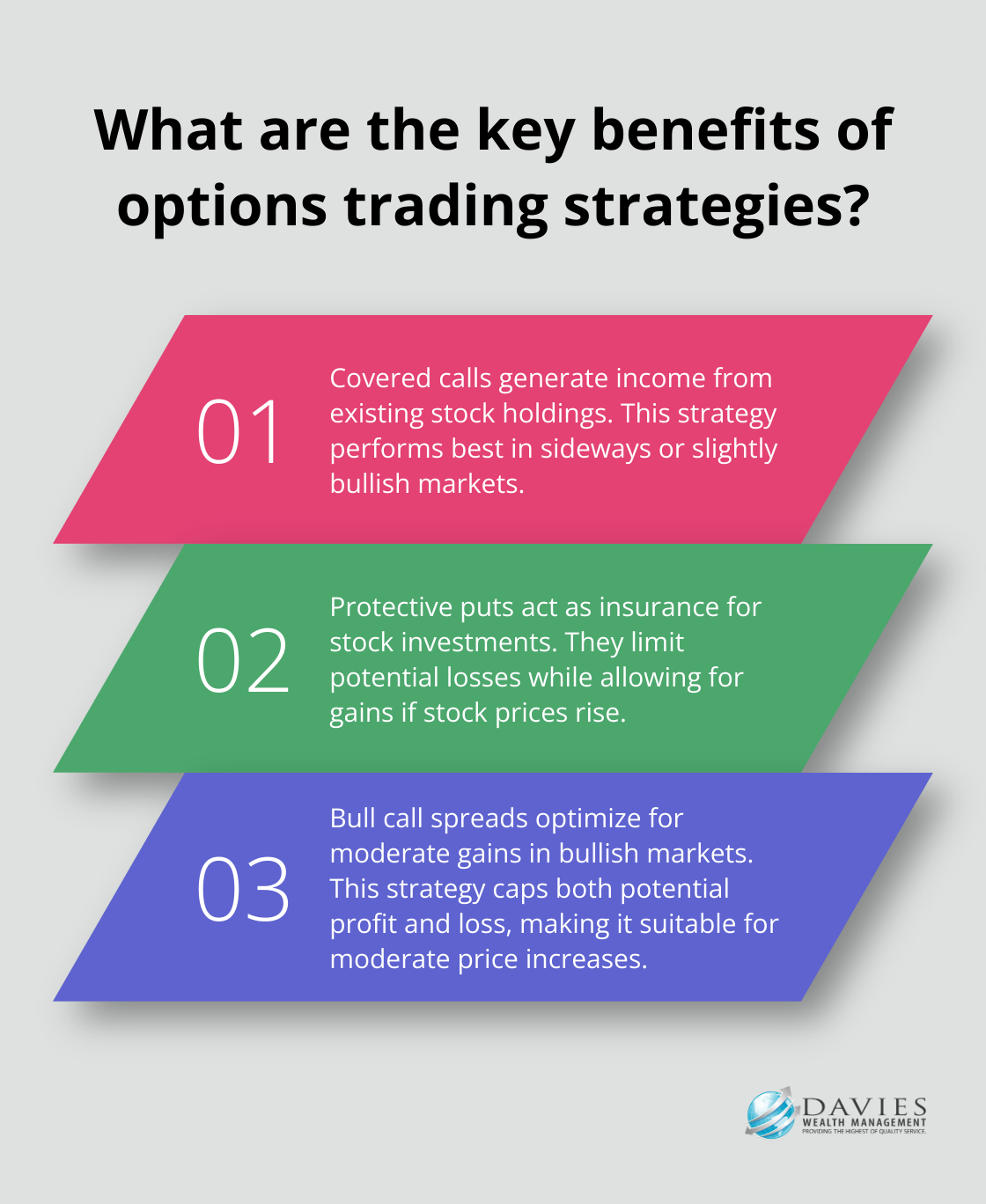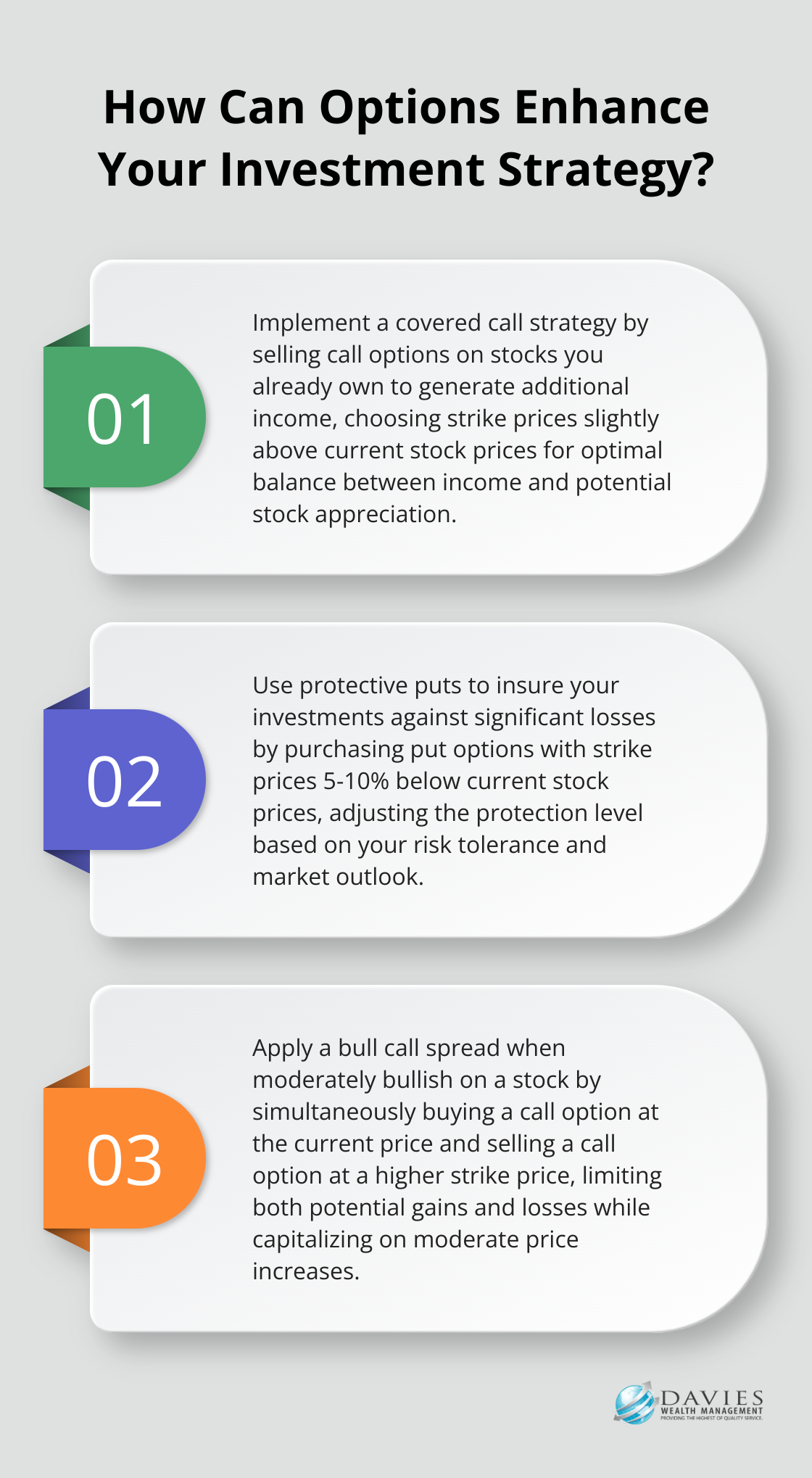Options investment strategies can be powerful tools for investors looking to enhance their portfolios. At Davies Wealth Management, we’ve seen firsthand how these techniques can help manage risk and potentially boost returns.
However, navigating the world of options requires a solid understanding of the basics and careful strategy selection. This guide will walk you through essential concepts and popular approaches to help you craft effective options strategies for your investment goals.
What Are Options and How Do They Work?
Options are financial instruments that provide investors with the right, but not the obligation, to buy or sell an underlying asset at a predetermined price within a specific timeframe. These powerful tools can enhance investment strategies when used correctly.
The Mechanics of Options
An option contract represents 100 shares of the underlying asset. The price at which you can buy or sell this asset is called the strike price, and the date by which you must exercise this right is the expiration date. If you don’t exercise the option by the expiration date, it becomes worthless.

There are two main types of options: calls and puts. A call option gives you the right to buy the underlying asset, while a put option gives you the right to sell it. For example, if you buy a call option for Stock XYZ with a strike price of $50 and an expiration date of June 30, you have the right to purchase 100 shares of XYZ at $50 per share until June 30, regardless of the stock’s market price.
Key Terminology in Options Trading
Understanding the language of options is essential for effective trading. While trading options, there are some key terms or phrases to remember. The premium is the price you pay to buy an option or receive when you sell one. It’s influenced by factors like the underlying asset’s price, time until expiration, and market volatility.
In-the-money (ITM) options have intrinsic value, meaning the current market price is favorable compared to the strike price. Out-of-the-money (OTM) options have no intrinsic value but may still have extrinsic value based on the potential for future price movements.
Advantages of Options Trading
Options offer several advantages. They can provide leverage, allowing you to control a large amount of stock with a relatively small investment. They can also be used for hedging, protecting your portfolio against potential losses. Many options strategies are designed to minimize risk by hedging existing portfolios. While options act as safety nets, they’re not risk free.
Risks Associated with Options
Options trading comes with significant risks. The leverage that makes options attractive can also lead to substantial losses if the market moves against your position. Time decay is another factor to consider – as the expiration date approaches, options lose value, which can erode your investment if you’re not careful.
It’s important to note that while options can be complex, they’re not inherently risky or safe. The level of risk depends on how you use them in your investment strategy. Professional financial advisors (like those at Davies Wealth Management) can help investors understand these nuances and develop strategies that align with their risk tolerance and financial goals.
As we move forward, we’ll explore popular options investment strategies that can help you harness the power of these versatile financial instruments.
Powerful Options Strategies for Smart Investors
Options trading can transform an investor’s portfolio performance. Let’s explore some of the most effective options strategies that savvy investors use to maximize returns and manage risk.
The Covered Call: Generate Income from Your Portfolio
The covered call strategy allows investors to generate additional income from their existing stock holdings. This approach involves giving someone else the right to purchase stock shares you already own at a specified price (strike price) and at any time on or before a certain date. You collect a premium upfront, which can provide a stream of income.

For example, if you own 100 shares of XYZ stock trading at $50, you might sell a call option with a strike price of $55 expiring in one month for a premium of $2 per share. This transaction immediately puts $200 in your pocket ($2 x 100 shares). If the stock price remains below $55 at expiration, you keep both the premium and your shares. If it rises above $55, your shares may be called away, but you’ve still profited from the premium and the stock appreciation up to $55.
The covered call strategy performs best in sideways or slightly bullish markets. It’s important to note that while this strategy can boost returns, it also caps your upside potential on the underlying stock.
Protective Puts: Insure Your Investments
You can insure your stock investments using protective puts. This strategy involves buying (or owning) stock and buying put options on a share-for-share basis.
Let’s say you own 100 shares of ABC stock at $100 per share. You’re concerned about potential market volatility, so you buy a put option with a strike price of $95 expiring in three months for $3 per share. This $300 investment ($3 x 100 shares) guarantees that you can sell your shares at $95 each, even if the market price drops below that level.
If ABC stock falls to $80, your put option allows you to sell at $95, limiting your loss to $5 per share plus the cost of the put. Without this protection, you would have lost $20 per share. However, if the stock price rises, your put option may expire worthless, but you’ll benefit from the stock’s appreciation.
The Bull Call Spread: Optimize for Moderate Gains
For investors who are moderately bullish on a stock but want to limit their risk, the bull call spread can be an excellent strategy. This approach is used when a trader expects a moderate rise in the price of an underlying asset. It involves buying a call option at one strike price while simultaneously selling a call option at a higher strike price, both with the same expiration date.
Consider a scenario where stock DEF is trading at $50. You believe it will rise to around $55 in the next month. You could buy a call option with a $50 strike price for $3 and sell a call option with a $55 strike price for $1. Your net cost is $2 per share ($3 – $1), or $200 for the spread.
If DEF rises to $55 or above by expiration, you’ll realize the maximum profit of $300 ($5 spread – $2 cost x 100 shares). Your breakeven point is $52, and your maximum loss is limited to your initial investment of $200.
This strategy allows you to benefit from a stock’s upward movement while capping both your potential profit and loss. It’s particularly useful when you expect moderate price increases or when options premiums are high due to increased volatility.
These strategies can be particularly effective for various investors, including professional athletes who often need to balance aggressive growth with prudent risk management. However, options trading requires careful consideration of your overall financial situation and goals. It’s always wise to consult with a financial advisor (such as those at Davies Wealth Management) before implementing these strategies in your portfolio.
As we move forward, we’ll explore more advanced options techniques that can further enhance your investment strategy and help you navigate complex market conditions.
Mastering Advanced Options Techniques
Delta Hedging: Precision Risk Management
Delta hedging is an options trading strategy that aims to reduce, or hedge, the directional risk associated with price movements in the underlying asset. This strategy requires investors to adjust their position in the underlying asset to maintain a neutral delta, which immunizes their portfolio against small price movements.

An investor who holds a long call option with a delta of 0.5 could short 50 shares of the underlying stock to achieve a delta-neutral position. As the stock price changes, the investor must continuously adjust the hedge to maintain neutrality.
Delta hedging proves particularly useful for individuals who need to protect large, concentrated positions (such as professional athletes or high-net-worth individuals). This strategy helps manage risk in volatile market conditions.
Volatility Trading: Capitalizing on Market Uncertainty
Volatility trading strategies allow investors to profit from changes in market volatility rather than directional price movements. The long straddle represents a popular approach, where an investor simultaneously buys a call and a put with the same strike price and expiration date.
For example, if a stock trades at $100, an investor might buy both a $100 call and a $100 put expiring in one month. This position profits if the stock makes a significant move in either direction, with the potential for substantial gains if volatility spikes.
The volatility skew refers to the uneven distribution of implied volatility across different strike prices and expiration dates of options contracts. While it requires careful analysis, trading based on volatility skew can yield impressive returns when executed correctly.
Income Generation Through Options
Options serve as a powerful tool for generating income, especially in low-yield environments. The cash-secured put strategy involves selling put options on stocks an investor is willing to own, potentially allowing them to acquire shares at a discount while collecting premium income.
Consider a stock trading at $50. If an investor feels comfortable buying it at $45, they could sell a $45 put option. If the stock remains above $45, the investor keeps the premium as income. If it falls below $45, the investor must buy the shares, but at a price they were already willing to pay.
The covered strangle combines a covered call with a cash-secured put. This approach can generate significant income but requires careful management of potential risks.
Advanced Techniques for Portfolio Optimization
Options strategies can enhance overall portfolio performance. One such technique involves using options to create synthetic positions. For instance, an investor can replicate stock ownership by buying a call option and selling a put option with the same strike price and expiration date. This strategy (known as a synthetic long stock position) mimics the gains and losses of owning stock without the actual purchase.
Another advanced technique uses options for tax management. By strategically using options to defer gains or harvest losses, investors can potentially optimize their tax situation. However, this approach requires a deep understanding of tax laws and should be implemented with the guidance of a tax professional.
These advanced options techniques can significantly enhance an investment strategy, but they also come with increased complexity and potential risks. Investors should thoroughly understand these strategies and how they fit into their overall financial plan before implementation. Professional guidance (such as that provided by Davies Wealth Management) can help navigate these sophisticated strategies and optimize portfolios for long-term success.
Final Thoughts
Options investment strategies provide investors with powerful tools to enhance portfolios, manage risk, and potentially increase returns. These strategies range from basic techniques like covered calls to advanced approaches such as delta hedging, offering flexibility in various market conditions. Successful implementation of these strategies requires a deep understanding of market dynamics and continuous learning to stay informed about new trends.

Professional guidance can significantly benefit investors who want to craft effective options investment strategies. At Davies Wealth Management, we specialize in tailoring investment approaches to individual needs, including those of professional athletes facing unique financial challenges. Our team can help navigate the complexities of options trading and ensure strategies align with overall financial goals.
The key to successful options trading lies in understanding the mechanics and integrating these strategies with your broader financial plan. Combining your knowledge with expert advice can help you harness the full potential of options to build, protect, and grow your wealth over time. Dedicating time to education, practice, and careful analysis of past trades will refine your skills and improve your decision-making process.



Leave a Reply